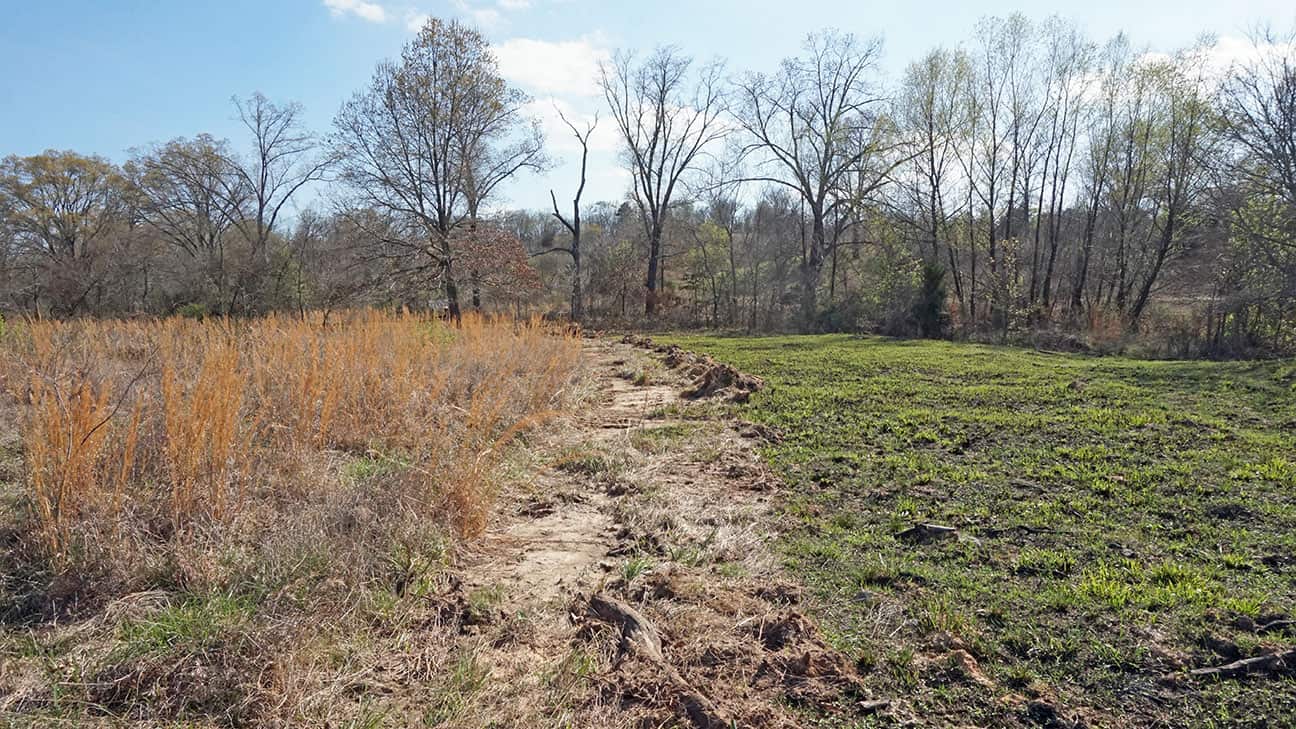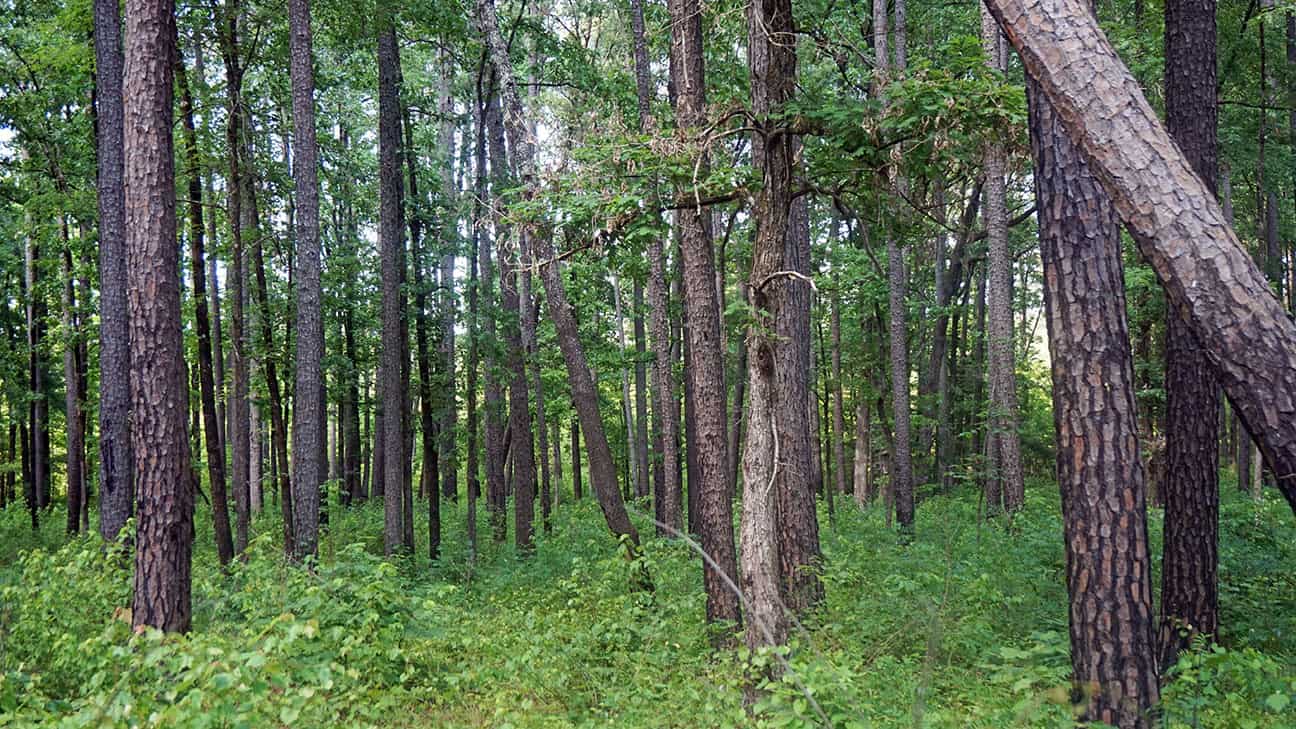
The effect of a March range fire. Left: natural meadow. Right: fresh grass springing to life on recently blackened ground.
Mahli Hvshi: Windy Month
Iti Fabvssa
March 1, 2019
This article is part of a series entitled “A Year in the Life”. Focusing on the time period around AD 1700, this series follows the traditional Choctaw calendar through a year, with each article providing a glimpse of the activities that our ancestors were up to during each month. This information is excerpted from a book, soon to be published by the Choctaw Nation, which is entitled “Choctaw Food: Remembering the Land, Rekindling Ancient Knowledge”.
Mahli Hvshi, Windy Month, roughly corresponds with March. During March, the lengthening days of late winter begin to bring warmer temperatures and wind. By the end of the month, the woods begin budding out, and new green growth peeks out from under the protective mat of dormant native grass. March is a time of transition in the landscapes of the Choctaw homeland, and it was also the time when our ancestors played their biggest role in shaping these landscapes — They set them on fire.
Today, wildfire has a bad reputation. We think of it burning down houses and destroying beautiful landscapes. Fire is nothing to play with, but it is also a natural part of the landscape and has a very important role to fulfill. Long before people were around, lightning strikes set fire to North America’s landscapes. Fires helped to recycle nutrients and reset ecological succession. Many native plant species adapted to fire in ways that helped the plants to seed, regenerate, and even helped to spread future range fires. By at least 10,000 years ago, our Native American ancestors had begun to use intentionally set range fires as a tool to manage the landscapes around them. Over time, these regularly set range fires opened up the woods, making travel easier. They made plant and animal habitat more diverse, increased the land’s carry capacity for deer, and improved the habitat for a number of culturally important plants.
Range fires have really only became a problem in more recent years, as people have built permanent homes in areas that are prone to fire. As land managers have worked to prevent wildfires, the landscape has become more dense in woody plant growth and less diverse. By working to prevent fire, land managers have often made the situation more dangerous, by allowing dead plant material to build up on the ground. When a fire eventually does get started, this extra plant material acts as a fuel that makes the fire hot enough to kill plant life as well as the microscopic organisms in the soil that help plants to regenerate. Today, many land managers, including Choctaw Nation Forestry, are working to bring fire back to the landscape. In honor of Windy Month, it is interesting to look at what managing the land with fire meant for our ancestors.

A mixed forest in the Choctaw homeland, managed by burning (Noxubee National Wildlife Refuge).
The season of a burn influences its effects on the landscape. A fire in late winter encourages a growth of forbs (non-woody vascular plants). A fire later in the spring encourages a luxurious, green growth of fresh grass. A fire that occurs during the hottest part of the year can bring more significant changes to the landscape because it is more likely to get hot enough to cause long-term damage.
As mentioned above, Choctaw land managers preferred March for conducting their burns (Cushman 1899:197). In the Choctaw homeland, a March range fire colors the ground black with carbon right at the time the new grass is ready to sprout. In the past, March fires supported a fresh growth of wiregrass in the southern part of Choctaw country and of bluestem grass species in the northern part (Romans 1999[1775]:97). The new grass, in turn, provided food for grazing and browsing animals, like bison and deer.
Studying the ancient sediments trapped in the bottom of bogs, it appears that our ancestors set fire to any given upland area about once every three years on average. Because the fires were regularly set across the landscape, they limited the available fuel load, preventing the occasional wildfire from getting hot enough to kill mature trees or significantly damage the microbes in the soil. These cooler fires had a patchy impact on the landscape; greater in the uplands and lesser in the stream valleys. As a whole, the fires cleared out brush and vines and increased plant spacing. This led early Euro-American visitors in the Choctaw homeland to describe it as an open, park-like environment (e.g. Hilgard 1873), something very different from what most of that region looks like today. On a more local level, the dense canebrakes of the Southeast were expanded by the practice of leaving low-lying agriculture fields fallow and periodically setting fire to the cane that moved in to stimulate new growth (Delecourt and Delecourt 2008:87; Platt and Brantley 1997:13). Range fires also temporarily decreased the abundance of some parasitic insects, such as ticks (cf. Scifres et al. 1988).
Today, we sometimes hear about the “pristine” “natural” landscapes that blanketed this continent before European arrival. In reality, they were neither fully natural nor pristine. These landscapes were shaped by our ancestors’ intentional management for thousands of years. Looking back, nowhere is this management better demonstrated than in seeing what our ancestors were up to during the month of March.
About Iti Fabvssa
Iti Fabvssa seeks to increase knowledge about the past, strengthen the Choctaw people and develop a more informed and culturally grounded understanding of where the Choctaw people are headed in the future.
Additional reading resources are available on the Choctaw Nation Cultural Service website. Follow along with this Iti Fabvssa series in print and online.
Inquiries
If you have questions or would like more information on the sources, please contact Ryan Spring at [email protected].

